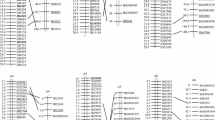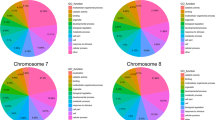Abstract
Genome-wide detection of short insertion/deletion length polymorphisms (InDels, <5 bp) in Brassica rapa (named the A genome) was performed by comparing whole-genome re-sequencing data from two B. rapa accessions, L144 and Z16, to the reference genome sequence of Chiifu-401-42. In total, we identified 108,558 InDel polymorphisms between Chiifu-401-42 and L144, 26,795 InDels between Z16 and Chiifu-401-42, and 26,693 InDels between L144 and Z16. From these, 639 InDel polymorphisms of 3–5 bp in length between L144 and Z16 were selected for experimental validation; 491 (77 %) yielded single PCR fragments and showed polymorphisms, 7 (1 %) did not amplify a product, and 141 (22 %) showed no polymorphism. For further validation of these intra-specific InDel polymorphisms, 503 candidates, randomly selected from the 639 InDels, were screened across seven accessions representing different B. rapa cultivar groups. Of these assayed markers, 387 (77 %) were polymorphic, 111 (22 %) were not polymorphic and 5 (1 %) did not amplify a PCR product. Furthermore, we randomly selected 518 InDel markers to validate their polymorphism in B. napus (the AC genome) and B. juncea (the AB genome), of which more than 90 % amplified a PCR product; 132 (25 %) showed polymorphism between the two B. napus accessions and 41 (8 %) between the two B. juncea accessions. This set of novel PCR-based InDel markers will be a valuable resource for genetic studies and breeding programs in B. rapa.





Similar content being viewed by others
References
Bhattramakki D, Dolan M, Hanafey M, Wineland R, Vaske D, Register JC 3rd, Tingey SV, Rafalski A (2002) Insertion–deletion polymorphisms in 3′ regions of maize genes occur frequently and can be used as highly informative genetic markers. Plant Mol Biol 48(5–6):539–547
Botstein D, White RL, Skolnick M, Davis RW (1980) Construction of a genetic linkage map in man using restriction fragment length polymorphisms. Am J Hum Genet 32(3):314–331
Datta S, Datta S, Kim S, Chakraborty S, Gill RS (2010) Statistical analyses of next generation sequence data: a partial overview. J Proteomics Bioinforma 3(6):183–190
Jander G, Norris SR, Rounsley SD, Bush DF, Levin IM, Last RL (2002) Arabidopsis map-based cloning in the post-genome era. Plant Physiol 129(2):440–450
Li R, Li Y, Kristiansen K, Wang J (2008) SOAP: Short Oligonucleotide Alignment Program. Bioinformatics 24(5):713–714
McCouch SR, Chen X, Panaud O, Temnykh S, Xu Y, Cho YG, Huang N, Ishii T, Blair M (1997) Microsatellite marker development, mapping and applications in rice genetics and breeding. Plant Mol Biol 35(1–2):89–99
Mills RE, Luttig CT, Larkins CE, Beauchamp A, Tsui C, Pittard WS, Devine SE (2006) An initial map of insertion and deletion (INDEL) variation in the human genome. Genome Res 16(9):1182–1190
Nagaraju J, Kathirvel M, Kumar RR, Siddiq E, Hasnain SE (2002) Genetic analysis of traditional and evolved Basmati and non-Basmati rice varieties by using fluorescence-based ISSR-PCR and SSR markers. Proc Natl Acad Sci USA 99(9):5836
Park S, Yu HJ, Mun JH, Lee SC (2010) Genome-wide discovery of DNA polymorphism in Brassica rapa. Mol Genet Genomics 283(2):135–145
Pollak E (1987) On the theory of partially inbreeding finite populations. I. Partial selfing. Genetics 117(2):353–360
Pompanon F, Bonin A, Bellemain E, Taberlet P (2005) Genotyping errors: causes, consequences and solutions. Nat Rev Genet 6:847–859
Powell W, Machray GC, Provan J (1996) Polymorphism revealed by simple sequence repeats. Trends Plant Sci 1(7):215–222
Rozen S, Skaletsky H (2000) Primer3 on the WWW for general users and for biologist programmers. Methods Mol Biol 132:365–386
Shen YJ, Jiang H, Jin JP, Zhang ZB, Xi B, He YY, Wang G, Wang C, Qian L, Li X, Yu QB, Liu HJ, Chen DH, Gao JH, Huang H, Shi TL, Yang ZN (2004) Development of genome-wide DNA polymorphism database for map-based cloning of rice genes. Plant Physiol 135(3):1198–1205
Tautz D (1989) Hypervariability of simple sequences as a general source for polymorphic DNA markers. Nucleic Acids Res 17(16):6463–6471
Vali U, Brandstrom M, Johansson M, Ellegren H (2008) Insertion–deletion polymorphisms (indels) as genetic markers in natural population. BMC Genet 9:8
Vos P, Hogers R, Bleeker M, Reijans M, van de Lee T, Hornes M, Frijters A, Pot J, Peleman J, Kuiper M et al (1995) AFLP: a new technique for DNA fingerprinting. Nucleic Acids Res 23(21):4407–4414
Wang X, Lou P, Bonnema G, Yang B, He H, Zhang Y, Fang Z (2005) Linkage mapping of a dominant male sterility gene Ms-cd1 in Brassica oleracea. Genome 48(5):848–854
Wang J, Wang W, Li R, Li Y, Tian G, Goodman L, Fan W, Zhang J, Li J, Guo Y, Feng B, Li H, Lu Y, Fang X, Liang H, Du Z, Li D, Zhao Y, Hu Y, Yang Z, Zheng H, Hellmann I, Inouye M, Pool J, Yi X, Zhao J, Duan J, Zhou Y, Qin J, Ma L, Li G, Zhang G, Yang B, Yu C, Liang F, Li W, Li S, Ni P, Ruan J, Li Q, Zhu H, Liu D, Lu Z, Li N, Guo G, Ye J, Fang L, Hao Q, Chen Q, Liang Y, Su Y, San A, Ping C, Yang S, Chen F, Li L, Zhou K, Ren Y, Yang L, Gao Y, Yang G, Li Z, Feng X, Kristiansen K, Wong GK, Nielsen R, Durbin R, Bolund L, Zhang X, Yang H (2008) The diploid genome sequence of an Asian individual. Nature 456(7218):60–65
Wang X, Wang H, Wang J, Sun R, Wu J, Liu S, Bai Y, Mun JH, Bancroft I, Cheng F, Huang S, Li X, Hua W, Freeling M, Pires JC, Paterson AH, Chalhoub B, Wang B, Hayward A, Sharpe AG, Park BS, Weisshaar B, Liu B, Li B, Tong C, Song C, Duran C, Peng C, Geng C, Koh C, Lin C, Edwards D, Mu D, Shen D, Soumpourou E, Li F, Fraser F, Conant G, Lassalle G, King GJ, Bonnema G, Tang H, Belcram H, Zhou H, Hirakawa H, Abe H, Guo H, Jin H, Parkin IA, Batley J, Kim JS, Just J, Li J, Xu J, Deng J, Kim JA, Yu J, Meng J, Min J, Poulain J, Hatakeyama K, Wu K, Wang L, Fang L, Trick M, Links MG, Zhao M, Jin M, Ramchiary N, Drou N, Berkman PJ, Cai Q, Huang Q, Li R, Tabata S, Cheng S, Zhang S, Sato S, Sun S, Kwon SJ, Choi SR, Lee TH, Fan W, Zhao X, Tan X, Xu X, Wang Y, Qiu Y, Yin Y, Li Y, Du Y, Liao Y, Lim Y, Narusaka Y, Wang Z, Li Z, Xiong Z, Zhang Z (2011a) The genome of the mesopolyploid crop species Brassica rapa. Nat Genet 43(10):1035–1039
Wang Y, Sun S, Liu B, Wang H, Deng J, Liao Y, Wang Q, Cheng F, Wang X, Wu J (2011b) A sequence-based genetic linkage map as a reference for Brassica rapa pseudochromosome assembly. BMC Genomics 12:239
Williams JG, Kubelik AR, Livak KJ, Rafalski JA, Tingey SV (1990) DNA polymorphisms amplified by arbitrary primers are useful as genetic markers. Nucleic Acids Res 18(22):6531–6535
Acknowledgments
The authors wish to thank Graham J King for valuable suggestions for manuscript correction. This work was supported by National High Technology Research and Development Program of China (863 Program, No. 2008AA10Z155) and Core Research Budget of the Non-profit Governmental Research Institution (ICS, CAAS, 1610032011011). This work was done in the Key Laboratory of Biology and Genetic Improvement of Horticulture Crops, Ministry of Agriculture, People’s Republic of China and the Sino-Dutch Joint Lab of Horticulture Genomics Technology in Beijing.
Author information
Authors and Affiliations
Corresponding author
Additional information
Communicated by R. Visser.
Electronic supplementary material
Details of the 639 InDel markers and verified polymorphisms between the two re-sequenced accessions, among seven accessions representing different cultivar groups and between two B. napus accessions or between two B. juncea accessions.
Below is the link to the electronic supplementary material.
Rights and permissions
About this article
Cite this article
Liu, B., Wang, Y., Zhai, W. et al. Development of InDel markers for Brassica rapa based on whole-genome re-sequencing. Theor Appl Genet 126, 231–239 (2013). https://doi.org/10.1007/s00122-012-1976-6
Received:
Accepted:
Published:
Issue Date:
DOI: https://doi.org/10.1007/s00122-012-1976-6




